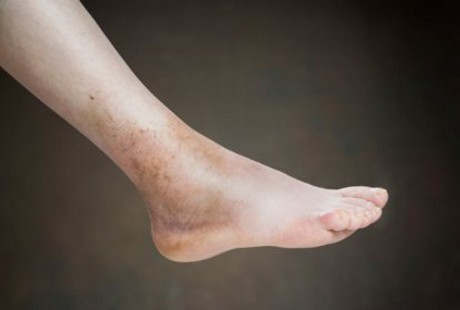 |
| Photo: Thinkstock |
Description
Buerger disease symptoms include:
1. Pain in the legs, arms or hands that may come and go.
2. Inflammation along the veins just beneath the skin's surface
3. Fingers and toes turn pale when exposed to cold
4. Painful sores on the fingers and toes.
Treatment
Other treatments include:
1. Medication to dilate blood vessels, increasing blood flow or blood clots
2. Intermittent compression of the arms and legs to increase blood flow to the extremities
3. Spinal cord stimulation
4. Surgery to cut the nerves to the affected area to control pain and improve blood flow, although this procedure is controversial
5. Drugs to stimulate the growth of new blood vessels (angiogenesis therapeutic)
6. Amputation, if infection or gangrene
Buerger's disease is a rare disease that attacks the arteries and veins in the arms and legs. Buerger disease causes blood vessels to become inflamed, swollen and clogged by a blood clot (thrombus). This eventually damages or destroys skin tissues and may lead to infection and gangrene.
Buerger's disease usually first occur on the hands, feet, and can ultimately affect a larger area. The disease is more common in Middle Eastern countries and affects people younger than 40 years. The condition is more common in women.
Cause
Unclear what triggers Buerger disease. It is possible that some people may have a genetic predisposition for the disease. This condition is characterized by inflammation in the arteries and veins in the arms and legs.
The cells that cause inflammation and swelling has formed in the blood vessels of the hands and feet and blocking blood flow to parts of the body. The reduced blood flow causes the skin tissue in the hands and feet are not getting enough nutrients and oxygen, causing pain and weakness in the affected limb.
SymptomBuerger disease symptoms include:
1. Pain in the legs, arms or hands that may come and go.
2. Inflammation along the veins just beneath the skin's surface
3. Fingers and toes turn pale when exposed to cold
4. Painful sores on the fingers and toes.
Treatment
Although there is no treatment that can cure Buerger's disease, the most effective way to stop the progression of the disease is to stop using all tobacco products. Even a few cigarettes a day can worsen the disease.
Other treatments include:
1. Medication to dilate blood vessels, increasing blood flow or blood clots
2. Intermittent compression of the arms and legs to increase blood flow to the extremities
3. Spinal cord stimulation
4. Surgery to cut the nerves to the affected area to control pain and improve blood flow, although this procedure is controversial
5. Drugs to stimulate the growth of new blood vessels (angiogenesis therapeutic)
6. Amputation, if infection or gangrene
Source: MayoClinic







